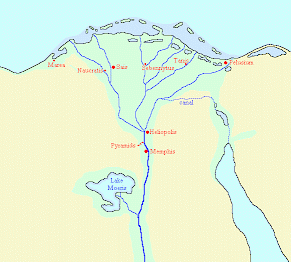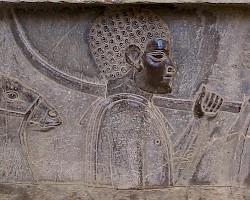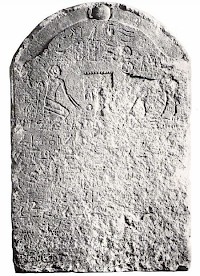Herodotus, bk 3, logos 7
Herodotus of Halicarnassus (c.480-c.429 BCE): Greek researcher, often called the world's first historian. In The Histories, he describes the expansion of the Achaemenid Empire under its kings Cyrus the Great, Cambyses, and Darius I the Great, culminating in Xerxes' expedition to Greece (480 BCE), which met with disaster in the naval engagement at Salamis and the battles at Plataea and Mycale. Herodotus' book also contains ethnographic descriptions of the peoples that the Persians have conquered, fairy tales, gossip, and legends.
The Persian conquest of Egypt (3.1-60)

In the first logos of the third book, Herodotus returns to the beginning of Book Two: the Persian king Cambyses' expedition to Egypt. He aligns himself with the Arabs (which offers Herodotus an opportunity to digress on their customs and habits), defeats the Egyptians at Pelusium (more...) and takes the Egyptian capitals Sais and Memphis.
After these initial successes and the execution of the last Egyptian ruler, Cambyses goes crazy. He desacrates the tomb of pharaoh Amasis and tries to attack Kush (modern Sudan; giving Herodotus a chance to show his knowledge of the customs of this country on the edges of the earth).

Both expeditions endin disaster, and after these failures, Cambyses orders several executions. His first victim is the sacredApis bull, who is mortally wounded by Cambyses in the thigh. Soon the king has his brother Smerdis killed by a secret agent namedPrexaspes, because he suspects the prince of an attempt to seize the throne for himself. Nobody knows about this murder. Cambyses' next victim is the son of Prexaspes, then a group of twelve noblemen. Finally, he ridicules the cult in an Egyptian temple, an incident that causes Herodotus to comment explicitly that this is the best proof that Cambyses was crazy, because only a madman would ridicule foreign customs (text).
Comment

Cambyses' expedition can be dated in 525. It is probable that Cambyses was succesful because the Egyptian admiral Wedjahor-Resne defected to the Persians at some stage before or during this war; in any case, nothing is known about naval operations. The Greek historian Ctesias of Cnidus, who is not known for his truthworthiness but may have had access to reliable information, explicitly mentions a traitor, although his name is Combaphis (Persica, §10). Ctesias also mentions the number of dead during the battle at Pelusium: 7,000 Persians and 50,000 Egyptians. These numbers are plausible.
The statement that Cambyses ordered the execution of his brother Smerdis (whose real name was Bardiya) is corroborated by the Persian Behistun inscription, in which Cambyses' successor Darius I the Great states the same (section 10). Of course, this does not prove that the secret murder is a historical fact, but we can be sure that Herodotus had access to the official Persian version of the incident.
The Apis bull, a manifestation of the Egyptian god Ptah, did in fact die during Cambyses' stay -in 524 BCE, to be precise- but the epitaph on his tomb states that it was of natural causes and that Cambyses dedicated the shrine. At this point, Herodotus reproduces an extremely anti-Persian tradition which he can easily have picked up if he visited Egypt during the revolt of Inarus and Amyrtaeus, Egyptian rebels who received Athenian support (464-449 BCE). In fact, there are reports that indicate that king Cambyses behaved himself as a pious ruler who did his best to make his rule acceptable to his new subjects. The best example is again the story of Wedjahor-Resne.